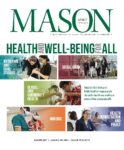It isn’t every class that you have electrodes attached to your head and your classmates gather around to watch your brainwaves in real time. But that is exactly what happens in BENG 499 Applied Neurotechnologies, a new technical elective that is a collaboration between the Volgenau School of Engineering’s Bioengineering Department and Inova Fairfax Hospital.
Mason bioengineering professor Laurence Bray, associate chair of Bioengineering, developed the course to help students gain firsthand experience in a clinical setting and prepare them for future study. The class combines classroom learning with a state-of-the-science clinical experience at Inova Fairfax Hospital’s campus.
“The class was a combination of the best of everything,” says senior bioengineering major Abdul Gouda. “There was clinical practice, classroom experience, teamwork, and some friendly competition.”
The specialized curriculum divides the semester into four segments, and each segment takes on a specific bioengineering skill or challenge. The segments include on-campus preparation and follow-up at Mason and hands-on lab experiences at Inova’s Advanced Surgical Technology and Education Center (ASTEC), one of the most technologically advanced surgery simulation facilities in the region.
After teaching these students for several years, Bray says she had a good idea of what kind of course would excite them. “When registration opened, the class filled up in half a day. The response was overwhelming.”
Bray designed the class with the cooperation of the Department of Surgery at Inova and two hospital neurosurgeons, Mahesh Shenai, MD, and James Leiphart, MD, who taught the clinical portion of the course at ASTEC.

Professor Laurence C. Bray works with students in the Applied Neurotechnologies class work on the Inova Fairfax Medical Campus. Photo by Evan Cantwell
“We learned the importance of teamwork and how to work together, despite different styles,” says Gouda. “The groups changed four times, so we were not with the same team throughout the semester, which was different. Usually we choose our own teams—in the real world that doesn’t always happen.”
“I’ve always wanted to work in a hospital,” says bioengineering major Anuradha Nagulapati. “Growing up in the area, Inova was the name I heard when people talked about hospital, so it was awesome to be there in the clinic.”
Nagulapati worked as Bray’s summer intern, helping with course preparation, and spent countless hours in the hospital. She says it was the first time she worked in a hospital setting with a health care team and interacted closely with physicians.
Both students are in the bioengineering pre-med concentration in the Volgenau School of Engineering, but say they may delay their applications to medical school.
Working in the hospital setting let us see all the different career fields for bioengineering graduates,” says Nagulapati. “I haven’t ruled out becoming a physician, but I think I might want to work as a clinical specialist for a few years first.”

No Comments Yet »
Leave a comment